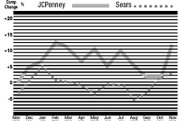2004 Retrospective Retail Sales Department Stores: JCPenney Sizzles, Sears Grabs Headlines
In 2004, discounters and moderate-priced stores found a chance to shine in an arena long dominated by Bentonville, Ark.–based Wal-Mart Stores Inc.
J.C. Penney Co. Inc. was one department store that rediscovered success in 2004. The Plano, Texas–based retail giant emerged from a fiscal 2003 laced with declining comparablestore sales to greet positive same-store sales in 2004. Revenue peaked in February, which boasted a 12.1 percent increase over sales of the previous year, and in November, when sales again rose 12 percent.
Promotions led crowds to the department store during this year’s blockbuster Black Friday, the traditional start of the Holiday season. The company’s bottom line also was helped by the August sale of its Eckerd drug store operation to Canada-based Jean Coutu Group—a transaction that netted JCPenney $3.5 billion in cash.
The fashion world will continue to watch JCPenney. On Oct. 27, the company named Myron Ullman chairman and chief executive officer. Ullman formerly was an executive with LVMH Moeuml;t Hennessy Louis Vuitton and led Macy’s through a reorganization that culminated with the company merging with Federated Department Stores Inc. in 1995.
Sears, Roebuck and Co., based in Hoffman Estates, Ill., did not have a good year financially. Comparablestore sales teetered between low single-digit positive sales and low single- digit negative sales. But financier Edward Lampert made headlines when his K-Mart Holdings, based in Troy, Mich., purchased Sears for $11 billion in November.
On paper, the marriage seems formidable because the combined company, with $55 billion in earnings, will be the third-largest retailer in the United States. But Wall Street investors wonder if merging two retailers with mediocre records will create one excellent company.
Sears is taking steps to prove itself. It recently opened its new super-store concept, Sears Grand, in Rancho Cucamonga, Calif., and is honing a marketing approach to capture the dollars of the multicultural residents living in major urban areas of the United States. The company is hiring more Spanish-speaking sales associates and transforming store signage and merchandise displays to highlight crossover appeal for non-English speakers and new immigrants. —Andrew Asch






















